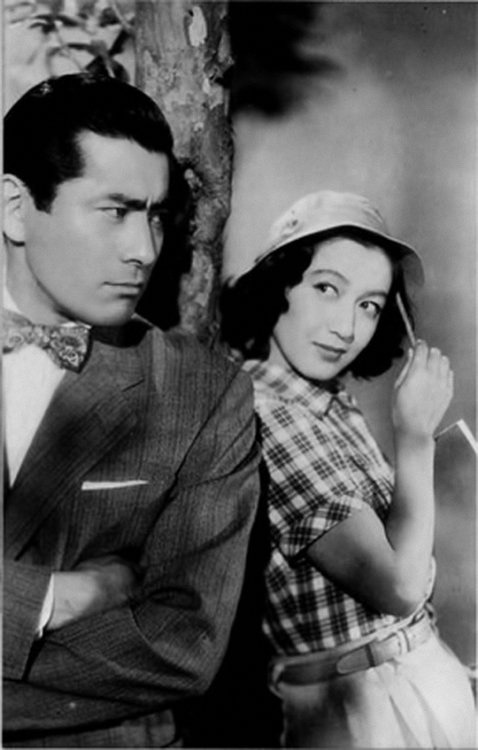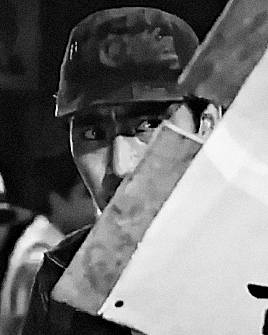#yasuki chiba
Text


# she said the shirt stays OFF
#Tokyo sweetheart#tokyo no koibito#setsuko hara#toshiro mifune#yasuki chiba#classicfilmsource#worldcinemaedit#classicfilmcentral#uservintage#asiandramasource#1950s#japanese movie#favourite x favourite#shgif#ellisgifs#same girl same#😮💨😮💨😮💨#their chemistry in this film is no joke#icb this was just a year after they starred together in the idiot sdhfgsdkj#such a different vibe#queue
2K notes
·
View notes
Text

Toshirô Mifune and Setsuko Hara in TOKYO SWEETHEART (Tôkyô no koibito), directed by Yasuki Chiba in 1952.
85 notes
·
View notes
Text






Tokyo Sweetheart (1952)
#🥺💜💜💜💜#tokyo sweetheart#tokyo sweetheart 1952#tokyo no koibito#setsuko hara#toshiro mifune#yasuki chiba#50s#mine
83 notes
·
View notes
Photo

Lobby card for Downtown (Shitamachi, 下町), 1957, directed by Yasuki Chiba (千葉泰樹) and starring Toshiro Mifune (三船敏郎) and Isuzu Yamada (山田五十鈴).
39 notes
·
View notes
Text
"In April 1962, a match pitting Japanese pro wrestling superstar Rikidozan and tag-team partners Toyonobori and Great Togo against American challengers Freddie Blassie, Lou Thesz, and Mike Sharpe aired nationally on Japanese television. During the bout, Blassie bit Great Togo on the forehead, opening a horrible bloody gash. Two elderly viewers, shocked by the gory sight, collapsed and died, casualties of a media war that saw networks and sponsors producing outrageous programs and stunts to grab the audience. Released later that year, Honda's King Kong vs. Godzilla is pop art imitating life, with two gargantuan wrestlers of Japanese and American pedigree tussling on live TV, raising ratings while razing cities. It's monster-movie-as-satire, a biting critique of the banal programming that dominated television, prompting widespread debate over the ascendant medium's effect on Japanese culture. The social critic Soichi Oya warned that TV was creating "a nation of 100 million idiots."
"People were making a big deal out of ratings," said Honda. "But my own view of TV shows was that they did not take the viewer seriously, that they took the audience for granted...so I decided to show that through my movie."
King Kong vs. Godzilla was one of five banner releases for 1962 to commemorate Toho's thirtieth anniversary, along with [Akira] Kurosawa's Sanjuro (Tsubaki Sanjuro), Hiroshi Inagaki's 47 Samurai (Chu-shingura), Mikio Naruse's Lonely Lane (Hourou-ki), and Yasuki Chiba's Born in Sin (Kawa no hotori de). By far Honda's most commercially successful film, King Kong vs. Godzilla was a runaway hit and the bedrock of the long-running Godzilla franchise that followed. Though Godzilla was a household word, this was the monster's first appearance in seven years. Only after Godzilla battled "the eighth wonder of the world" - Kong, the more popular monster, received top billing - did Toho truly begin producing its long and legendary series of monster-versus-monster sequels.
This is also perhaps Honda's most infamous effort, thanks to a poor imitation of the great King Kong and an inept, reworked American version that, as with Godzilla [1954], was distributed to many more territories than Honda's cut. Most troubling for Honda, though, was how Godzilla, in only its third film - and the first in color and scope - transformed from nuclear protest monster into outsized Rikidozan, engaging in comic wrestling antics. "[The studio] thought it would be interesting to make these two monsters fight," Honda later reflected. "That was all there was to it. Still, when you are the director, it is your film, so you still have to do your best. So I sucked it up and worked as hard as possible."
The project originated in Hollywood several years earlier, when stop-motion animator Willis O'Brien developed a proposed project titled King Kong vs. Frankenstein (later King Kong vs. Prometheus). O'Brien envisioned a battle in the streets of San Francisco between Kong and a monster created by Victor Frankenstein's grandson; the creatures would be animated via O'Brien's signature effects work. O'Brien partnered with independent producer John Beck, who failed to attract a Hollywood studio but eventually hit paydirt in Japan. Beck brokered a deal wherein Toho purchased the right to use King Kong in a film; however, O'Brien's ideas were jettisoned and he would have no involvement in the production. Toho made King Kong vs. Godzilla instead, with Beck retaining the lucrative overseas distribution rights.
RKO's fee for King Kong was reportedly 80 million Yen (about $220,000), inflating the budget and forcing Honda to cut costs. At the last minute, he canceled plans to film scenes set on Faro Island, Kong's home, on location in Sri Lanka. Instead, the crew shot at Oshima Island near Tokyo and on studio sets. "King Kong took all the money!" said actor Yu Fujiki.
Shinichi Sekizawa's script is light and quickly paced. Tako (Ichiro Arishima), the excitable advertising chief for Pacific Pharmaceutical Co., is desperate to shake up the low-rated TV science program that his company sponsors. He sends a cameraman, Sakurai (Tadao Takashima), and a sound man, Furue (Fujiki), to the Solomon Islands archipelago to investigate reports of a majin (demon god) worshipped by natives of tiny Faro Island. They return with King Kong literally in tow, but Kong breaks free in route and runs wild in Japan. Meanwhile, Godzilla bursts out of an iceberg in the Arctic and instinctively heads south toward its Tokyo stomping grounds. The Japanese military can't stop either creature, so a plan is hatched to pit them against one another, a monster matchup tailormade for the TV cameras.
King Kong vs. Godzilla takes a page from the keizai shosetsu (business novels) and films of the late 1950s and early 1960s that spoofed ruthless Japanese business practices. There are also similarities to Yasuzo Masumura's excellent Giants and Toys (Kedamono no yado, 1958), a satire about two candy companies engaged in an over-the-top media war, though where Masumura is cynical and heavy-handed, Honda is lighthearted. "The reason I showed the monster battle through the prism of a ratings war was to depict the reality of the times," said Honda. "When you think of King Kong just plain fighting Godzilla, it is stupid. But how you stage it, the times in which it takes place, that's the thought process of the filmmaker. Back then, Sekizawa was working on pop song lyrics and TV series, so he had a clear insight into television."
[Section omitted]
"This is neither the Kong of 1933 nor the Godzilla of 1954, and the monsters inspire little of their original pathos. Instead of moody monochrome, they are photographed in bright, revealing Eastmancolor and often framed at waist level, betraying any illusion of size. Godzilla has an improved design and blue-hot radiation breath; but Kong, played by stuntman Shoichi Hirose, is too obviously a man in a furry costume with lumpy facial features. Curiously, RKO reportedly required Toho not only to distinguish its Kong with a different face, but also to depict the ape snatching a female and scaling a building, recalling the original. Mie Hama does an excellent job shrieking in Kong's clutches, though one wishes Honda had borrowed even just a bit of the tragic romance of Merian C. Cooper's film. Godzilla mocks its opponent, Kong beats his chest and scratches his noggin, and both monsters employ slapstick fighting moves - Godzilla kicking boulders, Kong swinging its foe by the tail, and so on. Kong appears outmatched, but the odds are evened in the final battle via a deus ex machina, a thunderstorm that gives Kong a jolt of strength-inducing electricity."
[Section omitted]
"Because it was made not long after the AMPO protests, King Kong vs. Godzilla is sometimes interpreted as a critique of the Japan-US alliance, the monsters representing their respective countries. Studies such as Cynthia Erb's excellent Tracking King Kong make this analogy, but Honda had no such intent and, in fact, he portrays Kong as something of a proxy Japanese monster, with no apparent American origins. Unlike The Mysterians, Battle in Outer Space, Mothra, or Gorath, there is no involvement by the West in averting the crisis, and unlike Honda's 1950s dramas, the trappings of imported American culture (steaks and fries eaten with a fork and knife, jazz albums decorating Fumiko's apartment) are benign. Kong unintentionally helps expel Godzilla from Japan, playing the hero-by-default role that Godzilla would adopt a few years later. The fight ends in an apparent draw, then the monsters swim away - an ending to be repeated often, with variation."
- Ishiro Honda: A Life in Film, From Godzilla to Kurosawa, by Steve Ryfle and Ed Godziszewski
45 notes
·
View notes
Photo

ASOBINITE!!! -KYARY PAMYU PAMYU BIRTHDAY SPECIAL- YSTK×KPP CLUB EDITION (2017-01-28(Sat) OPEN 22:00 @Shin-Kiba ageHa@STUDIO COAST)
Like the years before there will be held a special ASOBINITE!!! to celebrate the birthday of Kyary Pamyu Pamyu on 28th January. The line-up includes Yasutaka Nakata, DAISHI DANCE, RAM RIDER, TeddyLoid feat. voia (ATTACK THE MUSIC), Fumihiko Chiba, naoya and YASUKI.
4 notes
·
View notes
Text








Toshiro Mifune in Tokyo Sweetheart (1952) dir. Yasuki Chiba
#toshiro mifune#tokyo sweetheart#yasuki chiba#worldcinemaedit#uservintage#cinemaspast#classicfilmcentral#asiandramasource#cinematv#filmgifs#japanese movie#japanese cinema#tokyo no koibito#ellisgifs#fofm#i watched this in such low quality 😩#release a restoration you cowards#anyway he looked soooooo good in this film
371 notes
·
View notes
Photo


沈丁花
4 notes
·
View notes
Text



Tokyo Sweetheart (1952)
#this look.#tokyo sweetheart#tokyo no koibito#setsuko hara#toshiro mifune#yasuki chiba#50s#mine#tokyo sweetheart 1952
79 notes
·
View notes
Photo

Lobby card for The Daphne (Jinchoge, 沈丁花), 1966, directed by Yasuki Chiba (千葉泰樹) and starring Yuriko Hoshi (星由里子), Reiko Dan (団令子) and Yoko Tsukasa (司葉子).
#The Daphne#沈丁花#Jinchoge#Yasuki Chiba#千葉泰樹#Yuriko Hoshi#星由里子#Reiko Dan#団令子#Yoko Tsukasa#司葉子#lobby card#Toho#japanese movie#japanese film#japanese cinema#classic film#classic japanese film
6 notes
·
View notes
Text




Tokyo Sweetheart (1952) dir. Yasuki Chiba
#tokyo sweetheart#tokyo no koibito#setsuko hara#toshiro mifune#yasuki chiba#japanese movie#japanese cinema#flickering tw#shgif#ellisgifs#favourite x favourite#love them so much I’m going to keep giffing this film even though the quality is so bad 😭
74 notes
·
View notes
Text




Toshiro Mifune and Setsuko Hara in Tokyo Sweetheart (1952) dir. Yasuki Chiba
#Tokyo sweetheart#setsuko hara#toshiro mifune#yasuki chiba#japanese movie#favourite x favourite#screencaps#their chemistry was sooooo good
39 notes
·
View notes
Text


Toshiro Mifune in Tokyo Sweetheart (1952)
#Tokyo sweetheart#toshiro mifune#tokyo no koibito#yasuki chiba#japanese movie#filmgifs#ellisgifs#suit!!!#he cleans up nice 👍#queue
7 notes
·
View notes
Text



Tokyo Sweetheart (1952)
#ok im done for now hehe#tokyo sweetheart#tokyo sweetheart 1952#tokyo no koibito#setsuko hara#toshiro mifune#yasuki chiba#50s#japanese cinema#dailyworldcinema#mine
38 notes
·
View notes
Text




Tokyo Sweetheart (1952)
31 notes
·
View notes
Text


Tokyo Sweetheart (1952)
#💜💜💜💜💜💜💜#tokyo sweetheart#tokyo sweetheart 1952#setsuko hara#toshiro mifune#yasuki chiba#tokyo no koibito#50s#50s film#mine
11 notes
·
View notes